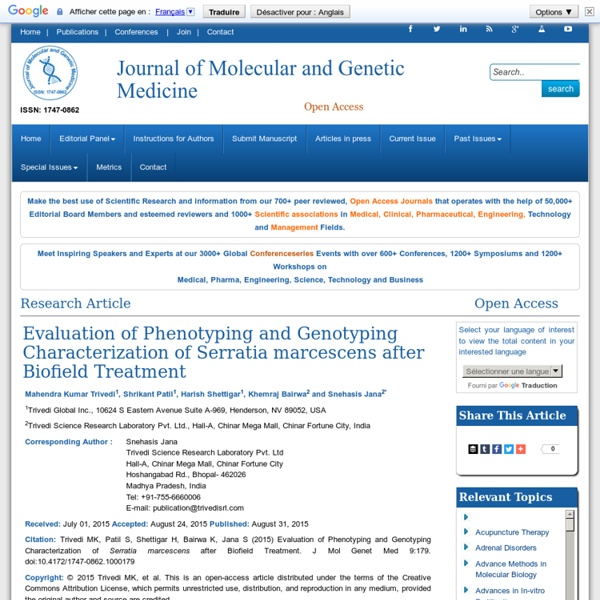The Potential Impact of Biofield Treatment on Human Brain Tumor Cells: A Time-Lapse Video Microscopy
Abstract Study background: Glioblastoma (GBM) is the most common subtype of primary brain tumor in adults. The aim was to evaluate the impact of biofield treatment potential on human GBM and non-GBM brain cells using two time-lapse video microscopy technique. Methods: The human brain tumor, GBM cultured cells were divided into two groups viz. GBM control and GBM treatment.
The Effect of Biofield Energy on Thymol & Menthol.
Abstract Thymol and menthol are naturally occurring plant derived compounds, which have excellent pharmaceutical and antimicrobial applications. The aim of this work was to evaluate the impact of biofield energy on physical and structural characteristics of thymol and menthol. The control and biofield treated compounds (thymol and menthol) were characterized by X-ray diffraction (XRD), Differential Scanning Calorimetry (DSC), Thermogravimetric analysis (TGA), and Fourier Transform Infrared Spectroscopy (FT-IR). XRD study revealed increase in intensity of the XRD peaks of treated thymol, which was correlated to high crystallinity of the treated sample.
An Effect of Biofield Treatment on Multidrug-resistant Burkholderia cepacia: A Multihost Pathogen
*The embed functionality can only be used for non commercial purposes. In order to maintain its sustainability, all mass use of content by commercial or not for profit companies must be done in agreement with figshare. Description
Thermal and Physical Properties of Biofield Treated Bile Salt and Proteose Peptone
Abstract Bile salt (BS) and proteose peptone (PP) are important biomacromolecules being produced inside the human body. The objective of this study was to investigate the influence of biofield treatment on physicochemical properties of BS and PP. The study was performed in two groups (control and treated).
Characterization of Physico-Chemical and Spectroscopic Properties of Biofield Energy Treated 4-Bromoacetophenone
Characterization of Physico-Chemical and Spectroscopic Properties of Biofield Energy Treated 4-Bromoacetophenone American Journal of Physical Chemistry Volume 4, Issue 4, August 2015, Pages: 30-37 Received: Sep. 19, 2015; Accepted: Sep. 30, 2015; Published: Oct. 16, 2015 Views 3435 Downloads 56 Authors
Thermal, Spectroscopic and Chemical Characterization of Biofield Energy Treated Anisole
Abstract The objective of the present study was to evaluate the impact of biofield energy treatment on the thermal, spectroscopic, and chemical properties of anisole by various analytical methods such as gas chromatography-mass spectrometry (GC-MS), high performance liquid chromatography (HPLC), differential scanning calorimetry (DSC), Fourier transform infrared (FT-IR) spectroscopy, and ultraviolet-visible (UV-Vis) spectroscopy. The anisole sample was divided into two parts, control and treated. The control part was remained same while the other part was treated with Mr.
Characterization of Physicochemical and Thermal Properties of Chitosan and Sodium Alginate after Biofield Treatment
Share this: Embed* Cite this: Trivedi, Mahendra Kumar (2015): Characterization of Physicochemical and Thermal Properties of Chitosan and Sodium Alginate after Biofield Treatment. figshare. Retrieved 07:04, Dec 04, 2015 (GMT) *The embed functionality can only be used for non commercial purposes.
Characterization of Physico-Chemical and Spectroscopic Properties of Biofield Energy Treated 4-Bromoacetophenone
Share this: Embed* Cite this: Trivedi, Mahendra Kumar (2015): Characterization of Physico-Chemical and Spectroscopic Properties of Biofield Energy Treated 4-Bromoacetophenone. figshare. Retrieved 06:35, Dec 04, 2015 (GMT) *The embed functionality can only be used for non commercial purposes.
Thermal, Spectroscopic and Chemical Characterization of Biofield Energy Treated Anisole
*The embed functionality can only be used for non commercial purposes. In order to maintain its sustainability, all mass use of content by commercial or not for profit companies must be done in agreement with figshare. Description The objective of the present study was to evaluate the impact of biofield energy treatment on the thermal, spectroscopic, and chemical properties of anisole by various analytical methods such as gas chromatography-mass spectrometry (GC-MS), high performance liquid chromatography (HPLC), differential scanning calorimetry (DSC), Fourier transform infrared (FT-IR) spectroscopy, and ultraviolet-visible (UV-Vis) spectroscopy. The anisole sample was divided into two parts, control and treated. The control part was remained same while the other part was treated with Mr.



